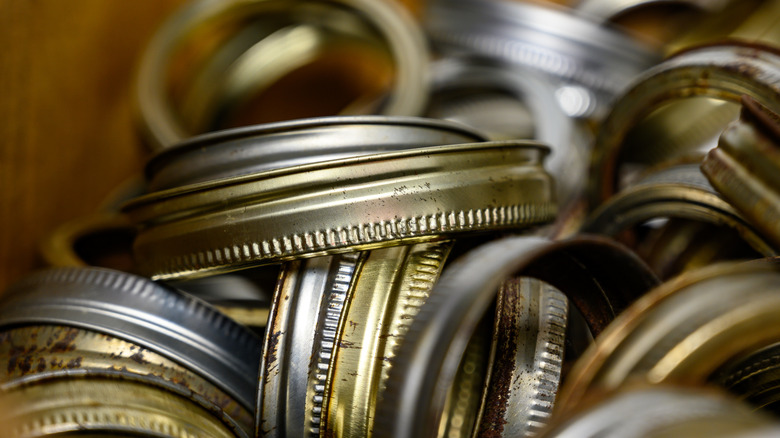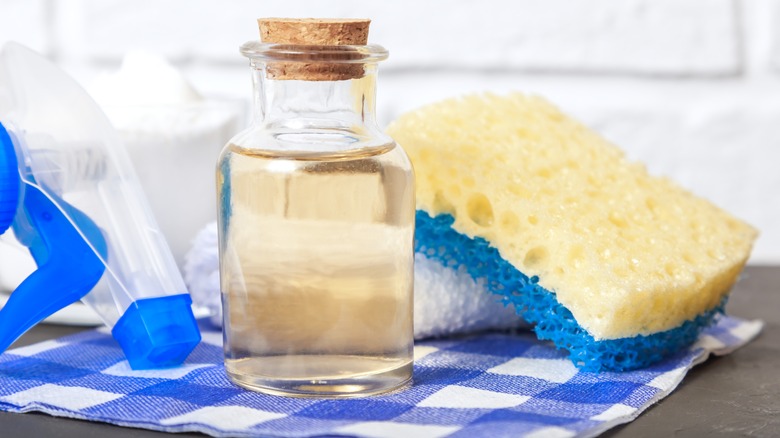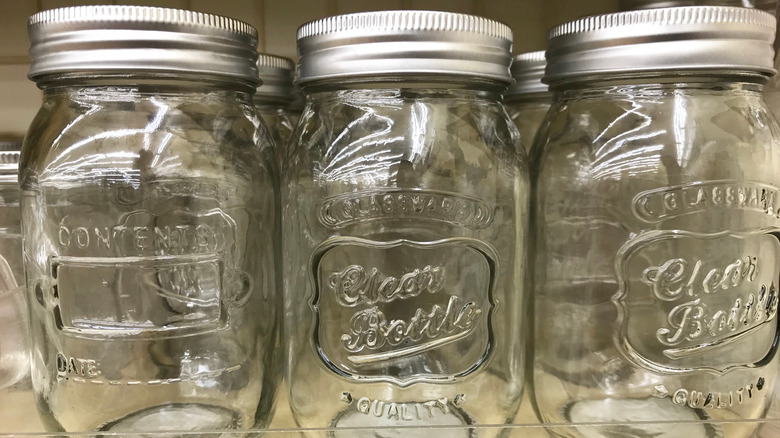Remove Rust From Old Canning Rings With A Household Staple You Already Have
Are old glass jars collecting dust in your home? You likely don't want to throw away those jars you spent so much on five years ago, and now you've gone into a canning frenzy. The trouble is that some jar rings are rusty after sitting around in the back of the cupboard for so long, and rusty canning lids are inherently unsafe. Rust may prevent jars from adequately sealing; germs can get into the jar and contaminate the food inside. No one wants to open a jar of carefully preserved last-season peaches only to find it spoiled. It's a waste of money and a serious health hazard.
Don't discard those bands right away, though. If the rust is surface-level only, you can clean them. All you need is a bottle of vinegar, a rag or scouring pad, and something to place the rings in while they're soaking. Distilled vinegar is a mix of acetic acid and lots of water. Acetic acid is the active ingredient in vinegar, and it removes rust from metal by transforming iron (the brown stuff rust is made of) into ferric acetate. This soluble compound dissolves in vinegar. The vinegar turning brown and the metal getting its shine back indicates that the chemical reaction you want to take place is, well, taking place!
Go vinegar shopping
You might think 30% cleaning vinegar will clear rust the fastest. That's not the case. Of all the kinds of vinegar out there, kitchen vinegar at 5% acetic acid works just as well as more concentrated forms. The chemical reaction is the same, so whatever vinegar you have on hand is the cheapest and most convenient. If you're hesitant to use that fancy organic apple cider vinegar to clean a bunch of canning jar bands, your next best option is white distilled vinegar. Don't add any bleach to your mixture. Mixing the two creates health-harming chlorine gas. To ensure the lids are clean from a health-safety standpoint, wash them thoroughly after removing the rust.
Table salt is a safe and effective addition for boosting vinegar's rust-removing power. Get 1 pound of all-purpose table salt at your local supermarket. Other things you'll need for this cleaning task include a container for soaking your rusty lids in (a bucket, an upcycled takeaway container, or even just a plugged kitchen sink), a scouring pad or metal brush (for really rusty rings), rags or paper towels (for spots of rust), and a source of fresh water. And although there's no denying vinegar can be a versatile cleaning tool, remember that the EPA doesn't approve it as a disinfectant.
The process of removing rust
Place your rusty rings in a clean container that holds at least a gallon of liquid. Measure 1 gallon of vinegar and 1 cup of table salt if you're using it. Pour everything into the container once the bands are wholly submerged — add more vinegar if they aren't. Soak the lids for anywhere from 30 minutes to three days, with most advice pointing to overnight as the sweet spot. Once you start seeing grey patches through the rust, it's time to start scrubbing. Pick up each ring individually and rub off any remaining rust spots with a rag. Tackle stubborn rust with a scouring pad or metal brush. Dry the lids thoroughly before stowing them away for next time.
How can you avoid the lids getting rusty in the first place? Washing rings in hard water or running them through the dishwasher is tough on them. Clean them by hand in distilled or purified water instead. During canning, cover the mouth of the jar with plastic cling film or coat the lids in olive oil before screwing the rings onto the jars. This creates a barrier against rust-causing moisture. How you store your canning jar bands matters, too. Separate the rings from the jars; attached lids are prone to rust and may get stuck. Store everything in a clean, dry cupboard. Of course, you could always skip this and invest in new stainless steel canning rings. They rarely rust.


